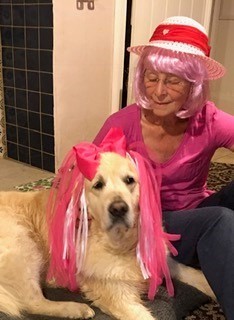My story
In Singapore in my late 20’s when swinging from a tree on a liana (a woody vine) with a group of children like Tarzan (or was it Jane?), the vine caught the side of my breast causing inflammation and an abscess to form in a cyst. I eventually had the cyst removed and was told then that I had dense breast tissue with calcification which presented a small risk of cancer in the future. My risk factors (including taking HRT) increased over time and I knew my chances of developing breast cancer were quite high. Even so, when the Senior radiologist told me (a few days before Christmas 2014) that she was 99.9% sure that I had a breast cancer, it was not what I wanted to hear in my 69th year but I was not surprised. What a Christmas present!

My first experience of breast cancer was as a student nurse in 1964. It was whispered that a 32-year-old lady had been admitted to the ward with breast cancer. Of course, in those days the big C was never mentioned and patients not told. A biopsy (a frozen section) would be done under anaesthetic and a mastectomy performed if confirmed. It was only on waking that the patient would learn the result of the operation.
I spent forty years (as a Health Visitor, teaching and working with children) promoting healthy lifestyles and advocating positive health measures, applying it first to myself of course. To reduce my risk, I followed any advice I could find including cutting out caffeine in 1988 as, according to an eminent breast surgeon at the time, it was linked to breast lumps. We now know that caffeine can cause a number of problems but probably not breast cancer! The lack of information in the past stopped those at risk from taking preventative measures.
We have come a long way and Breast Cancer Now are no doubt pioneers in the field. However, we cannot stop now if we are to meet their goal that by 2050, everyone who develops breast cancer will live - and live well.
Speaking up for breast cancer patients
For me, becoming a Patient Advocate was about making a difference. I felt with my background and diagnosis of breast cancer I could speak up and represent others who might not themselves be able to do so.
I took part in a clinical trial linked to Her2+ cancer and regularly attended a breast cancer support group. I found the group helpful to me in my early days after diagnosis and in turn, was then able to support others. When I saw a request for Patient Advocates it was an obvious next step for me.
My own experience helped bring an objective perspective
In the first year, I participated in the evaluation of patient and staff surveys from Nottingham. In the second year, I was invited to act as Patient Advocate at one of the country’s most famous hospitals, St. James’s in Leeds. I was also able to visit the Thackray Medical Museum next door, viewing equipment that I had used myself in the sixties - an added bonus!
The patient workshop was well attended. I felt a strong sense of empathy as I recalled my own experiences. As patients highlighted their main concerns a number of emotive topics emerged. The patients’ views reflected the feelings raised in the survey and soon specific issues were identified. My own experience had been very positive and I felt I was able to offer useful suggestions. The points identified were drafted into a proposal to place before the hospital team. I then presented these findings to the staff forum, where a patient-centered action plan was defined.
It was clear that staff were open to ideas and suggestions and wanted what was best for their patients. The response was very positive and although there were constraints of time, money and resources, there was definitely a willingness to improve their provision. I feel confident that St. James’s breast cancer patients will benefit greatly from their newly formed Service Pledge.
Always striving to improve
What did emerge from these surveys and meetings that has not yet been fully addressed is the long-term care of patients. In both hospital surveys and the meetings there was a clear message that some patients felt ‘abandoned’ after their initial treatment. There was also an absence of a voice from minority groups. As Patient Advocates, we need to continue to speak out on these issues in an ongoing quest ‘to make things better’.
To find out more about the Service Pledge and becoming a patient advocate, take a look at our Service Pledge page.